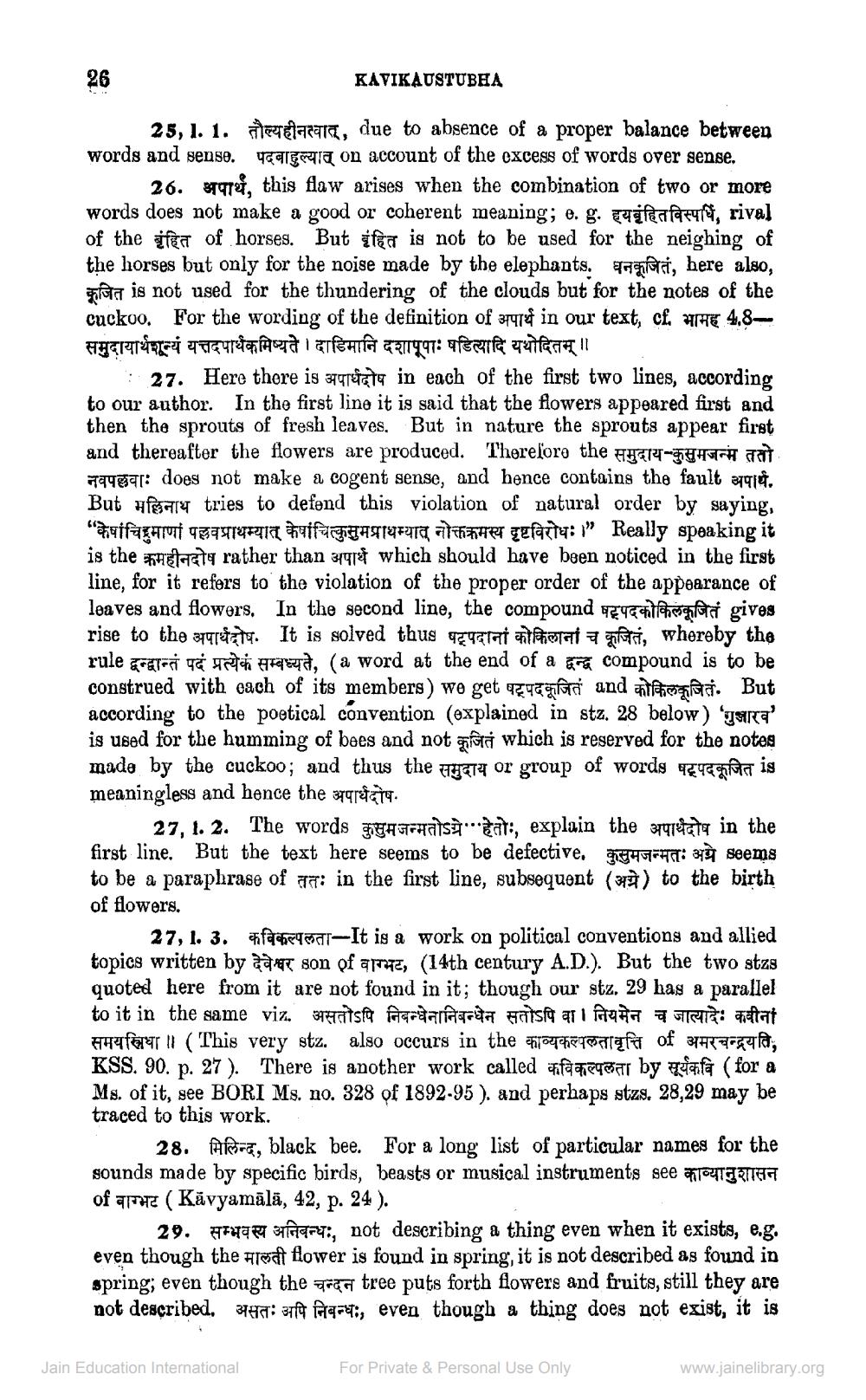________________
KAVIKAUSTUBHA
25, 1. 1. Derelakang, due to absence of a proper balance between words and sense. Calcala on account of the excess of words over sense.
26. Barat, this flaw arises when the combination of two or more words does not make a good or coherent meaning; e. g. Cafeafarer, rival of the gifta of horses. But it is not to be used for the neighing of the horses but only for the noise made by the elephants. hari, bere also, Saat is not used for the thundering of the clouds but for the notes of the cuckoo. For the wording of the definition of 39474 in our text, cf. HE 4.8 समुदायार्थशून्यं यत्तदपार्थकमिष्यते । दाडिमानि दशापूपाः षडित्यादि यथोदितम् ।।
27. Here there is aretata in each of the first two lines, according to our author. In the first line it is said that the flowers appeared first and then the sprouts of fresh leaves. But in nature the sprouts appear first and thereafter the flowers are produced. Therefore the A rt-HSCH TOT 79489r: does not make a cogent sense, and hence contains the fault 27914. But ufory tries to defend this violation of natural order by saying, "malfalam #ra haifa flyFra her yefaria:1 Really speaking it is the stata rather than 3497 which should have been noticed in the first line, for it refers to the violation of the proper order of the appearance of leaves and flowers. In the second line, the compound Ethicagoforai gives rise to the अपार्थदोष. It is solved thus षट्पदानां कोकिलानां च कूजितं, whereby the rule Granite cha maad, (a word at the end of a great compound is to be construed with cach of its members) we get agyagihan and the stat. But according to the poetical convention (explained in stz. 28 below) are' is used for the humming of bees and not get which is reserved for the notes made by the cuckoo; and thus the wysta or group of words agyagtata is meaningless and hence the अपार्थदोष.
27, 1.2. The words कुसुमजन्मतोऽग्रे"हेतोः, explain the अपार्थदोष in the first line. But the text here seems to be defective. 466: 9 seems to be a paraphrase of q: in the first line, subsequent (a) to the birth of flowers.
27, 1. 3. If yot-It is a work on political conventions and allied topics written by a son of a priz, (14th century A.D.). But the two stzs quoted here from it are not found in it; though our stz, 29 has a parallel to it in the same viz. so fargarh Hitsa ati fara a a pa: matat समयस्त्रिधा ॥ ( This very stz. also occurs in the काव्यकल्पलतावृत्ति of अमरचन्द्रयति, KSS. 90. p. 27). There is another work called affaqiqamar by pufa (for a Ms. of it, see BORI Ms. no. 328 of 1892-95). and perhaps stzs. 28,29 may be traced to this work.
28. Apr., black bee. For a long list of particular names for the sounds made by specific birds, beasts or musical instruments see auga of amaz ( Kāvyamālā, 42, p. 24).
29. He starti, not describing a thing even when it exists, e.g. even though the real flower is found in spring, it is not described as found in spring; even though the great tree puts forth flowers and fruits, still they are not described. 37870: 370 qrati, even though a thing does not exist, it is
Jain Education International
For Private & Personal Use Only
www.jainelibrary.org




